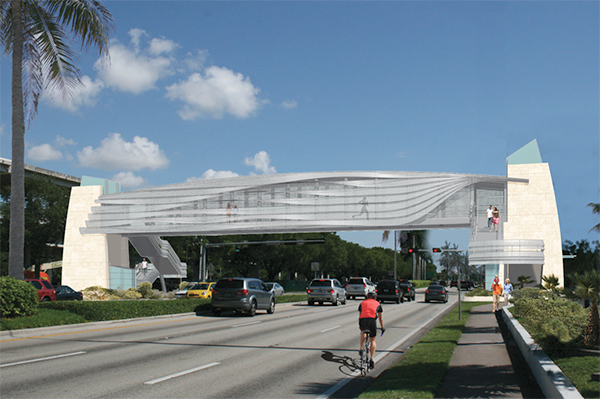
After several hurdles, plans for a pedestrian bridge that will allow UM students to cross U.S. 1 well above speeding cars and distracted drivers are finally concrete.
All legal and budget issues have been resolved, and Miami-Dade County is now in the process of finalizing the design before construction commences. The Mediterranean-style bridge will stretch from University Station to Mariposa Court, landing students by popular destinations like T.G.I. Friday’s and Bagel Emporium.
County commissioners unanimously approved a resolution to allow the county to take possession of Mariposa Court from the city of Coral Gables on July 2, clearing the way for the $6 million project to ensue.
Commissioner Xavier Suarez, who sponsored the resolution, said in an email that he promised to monitor the progress of the bridge through to completion.
Although the bridge is a county project and UM is not involved in funding or construction, Student Government (SG) and UM administrators have been pushing for the bridge for years, citing eight students who have been killed or seriously injured crossing U.S. 1 since 1989.
SG President Bhumi Patel said the bridge was the first issue she took on after being elected and that she is one in a long line of SG members who have pursued it since 2005 when UM student Ashley Kelly was struck and killed by an SUV that ran a red light.
Patel spoke to city commissioners in May and attended the county commission meeting alongside President Donna E. Shalala in July.
“As far as I know, at this point it’s out of our hands,” Patel said. “I’m just excited that we’re finally going to get it, and that campus will be a safer place for students.”
Albert Hernandez, assistant director of engineering, planning and development for Miami-Dade Transit, said he expects construction to start at the end of 2014 and wrap up by the end of 2015. The county will need to complete the final redesign, which involves small structural changes, acquire permits and procure a contractor before then.
Getting the project off the ground was no easy task. Plans have been halted repeatedly, first due to budget issues in 2008, then again when the owner of the University Centre strip mall refused a $1.8 million offer from Miami-Dade County for five parking spots needed to land the bridge.
The impasse prompted SG to hold a press conference and circulate a petition that garnered more than 2,700 signatures, but the county has sidestepped the problem with a strategy that doesn’t involve University Centre.
Mariposa Court will be reduced from three to two lanes, narrowing the road and creating space for a wider sidewalk where the bridge can land. The current left-turn and right-turn lanes will be combined into a dual-purpose lane that will feed cars onto U.S. 1 in both directions.
Once the road is restructured and the bridge is in place, the existing crosswalk will be closed to pedestrians and they will have to climb stairs or take the elevator up to the bridge to cross.
Hernandez recalled thinking at one point that the bridge might not happen, but he didn’t want to give up.
“I told my staff, ‘Hey, listen, before we abandon this, we need to take a very strong look,’ ” he said. “We’ve got to think outside the box, and we’ve got to see what opportunities there might be to fit the bridge maybe within the public right of way.”
Hernandez was more than happy with what they came up with. He estimated that the bridge will save the county about $1 million and believes it might actually improve traffic because the time that currently goes to pedestrians can be used to clear the queue of cars waiting to turn onto U.S. 1.
“We really actually feel that the silver lining is that it’s a better solution than having it at the shopping center,” Hernandez said.
During construction, pedestrians may have to be rerouted temporarily.
Freshman Gabriella Arancio said she crosses the intersection about four times a week to go to CVS and is looking forward to using the bridge because she feels like she can’t trust the walk signal.
“It feels like the sign is fake, honestly, like cars are always coming at me,” she said. “It says to walk, but I feel like you have to use your better judgment.”
Pat Whitely, vice president of student affairs, said the university community will be kept informed of progress and any obstacles that happen to arise, although she doesn’t anticipate any.
For his part, Hernandez is cautiously optimistic after more than a decade of working toward the bridge.
“It’s very satisfying, but I don’t want to celebrate too much,” he said. “I’ll do the celebrating when this thing is built.”






